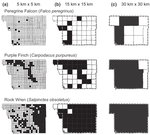Abstract
1. Reliable methods to downscale species distributions from coarse to fine grain (equivalent to resolution or support) hold great potential benefit for ecology and conservation. Existing methods have been based on partially unrealistic assumptions and yield mixed results.
2. Here, we introduce a novel and simple approach for downscaling species distribution models based on a hierarchical Bayesian modelling (HBM) framework. Our approach treats putative (unknown) fine-grain presences/absences as latent variables, which are modelled as a function of observed fine-grain environmental variables and constrained by observed coarse-grain presences/absences using logistic regression. The aim is to produce downscaled fine-grain probabilities of species occurrence that (1) closely resemble the probabilities produced by a logistic model parameterized with the observed fine-grain data (the ‘reference model’) and (2) are improvements over conventional downscaling methods. We additionally test how fine-grain occupancy based on power-law scale-area relationships modifies the downscaling results. We test our approach on 127 bird species from the San Diego breeding atlas data surveyed at 5 km grain.
3. The HBM approach provides unbiased fine-grain probabilities of occurrence whilst the conventional methods (direct approach, point sampling) consistently over-predict occurrence probabilities. Incorporation of the downscaled occupancy further improves reliability of the models, but only in cases when the fine-grain occupancy is estimated accurately.
4. Summing predictions across grid cells and species, HBMs provide better estimates of fine-grain species richness than conventional methods. They also provide better estimates of fine-grain occupancy (prevalence).
5. The presented HBM-based downscaling approach offers improved predictions of fine-grain presence and absence compared with existing methods. The combination of the Bayesian approach with key macroecological relationships (specifically, the scale-area relationship) offers a promising general basis for downscaling distributions that may be extended, for example, using generalized linear or additive models. These approaches enable integrative predictions of spatial biodiversity patterns at fine grains.
